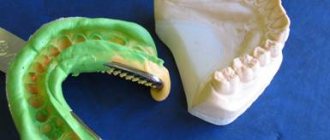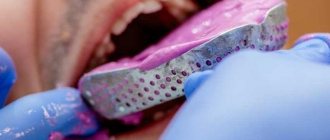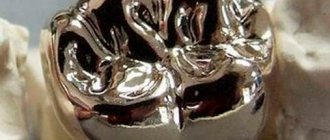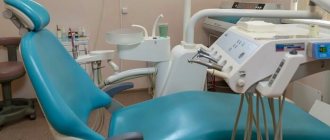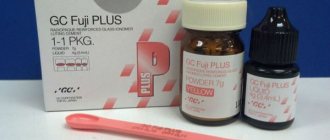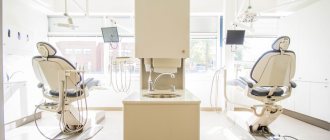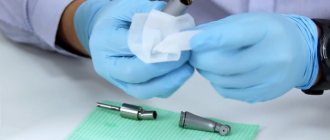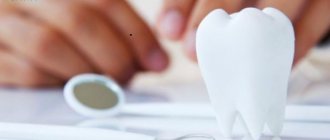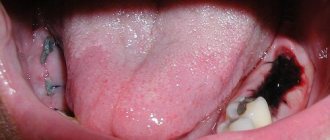An impression is one of the important elements of dental work, serving as a means of communication between the doctor and the dental technician. A copy of the jaw row, which is a kind of “sketch,” is used to reflect elements that need correction, as well as to form a prototype of the future replacement structure. Understanding technical capabilities, taking into account nuances to eliminate further adjustments, as well as competent planning and forecasting are factors that determine the successful use of a dental impression.
General overview
From a technical point of view, the impression is a negative, reflecting the position of the elements of the dentition and the surrounding tissues of the oral cavity. Based on the impression, a positive is created - a model that actually copies the anatomical structure of the jaw, which serves to form a replacement structure. The term "impression", which is quite common in dentistry, is usually used to describe a positive, relief prototype made of plaster or silicone. The formulation “taking an impression of the dentition” can be considered as a definition that combines two procedures: taking an impression and forming a model.
Classification
Differentiation adopted in dentistry involves dividing impressions into two categories:
- Working, or precision – precise impressions used to create functioning replacement structures installed on a permanent or removable basis;
- Auxiliary - as the name implies, this group combines all additional impressions that eliminate information gaps and make it possible to clarify the specifics of the occlusal relief to improve the quality of wearing the prosthesis.
Another category is occlusal recorders, whose task is to functionally complement and combine these types of impressions. If there are a sufficient number of surviving units, their use is not always advisable, but the desire to achieve optimal occlusion and shorten the adaptation period are good reasons for using recorders.
In terms of the number of jaws represented by the impression, there are one- and two-jaw options, with the second option being used much less frequently in dentistry. The effectiveness of using a separate impression for each row of teeth is determined by the quality of the resulting pattern.
Based on the technique of designing the marginal areas, anatomical and functional impressions are distinguished, however, it is quite difficult to establish a clear line of differentiation between them. Functional variation involves the use of clarifying movements of active and passive properties, allowing one to obtain additional information necessary for the formation of a prosthetic system. In turn, anatomical impressions are used for permanent replacement, when technical interest is primarily in the characteristics of the tissue structure of the prosthetic bed, while the marginal design loses its original priority.
Disinfection of impressions, dentures, products
Metal impression trays are cleaned of impression material residues and immersed in a disinfectant solution. Disinfection and pre-sterilization cleaning are recommended to be carried out in baths using ultrasonic cleaning. Sterilization is carried out by chemical, steam or air methods. When using physical methods, spoons are stored in the packaging in which sterilization was carried out. If impression trays are sterilized without packaging, they should be placed on sterile tables under a sterile drape or in cabinets with an ultraviolet irradiator. In this case, the spoons are used during the working day. Plastic spoons that cannot be sterilized must not be reused. All instruments, products and materials must be thoroughly disinfected before being sent to the dental laboratory. Impressions obtained in the office are always infected with oral microflora, oral fluid, blood from the injured periodontal mucosa during tooth preparation or inflamed periodontal tissue, discharge from pathological periodontal pockets, and dental plaque. First, the impressions are washed under running water to remove saliva, blood and foreign matter (in compliance with anti-epidemic measures - rubber gloves, an apron). After this, they are immersed in a disinfectant solution corresponding to the material from which the impressions were made. It is important that the disinfectant solution does not cause deformation of the impression. For disinfection, it is recommended to use solutions whose exposure time does not exceed 30 minutes (table).
Impression disinfectants
After disinfection is completed, impressions and denture blanks are washed with running water for 0.5 minutes on each side or immersed in a container with water for 5 minutes, after which they are dried in air. The impression processing agent is used repeatedly throughout the week, processing no more than 50 impressions. When the first signs of a change in the appearance of the solution appear, it should be replaced. Impressions made of alginate, silicone materials, polyester resin and hydrocolloid, denture blanks made of metal, ceramics, plastics and other materials, corrosion-resistant articulators are disinfected in the following sequence : - blanks are first washed with water, observing the rules of personal protection (rubber apron, gloves); — immersed in a disinfectant solution in accordance with the modes indicated in the table; - rinse with running water for 30 seconds on each side or immerse in a container of water for 5 minutes. MD-520 is used repeatedly throughout the week, and no more than 50 prints are processed. If the solution changes color during use, flakes appear, etc., it should be replaced immediately. ADS-521 - used repeatedly until signs of contamination appear, but no more than a day. Products are washed for 5 minutes. Delansal - no more than 30 products are disinfected in two liters of solution. Products are washed for 10 minutes under running water or in 2 containers with water for 10 minutes each. Lizafin - used repeatedly until signs of contamination appear. In this case, the number of impressions immersed in 2 liters of solution should not exceed 20. Lumax Dental - used repeatedly for 7 days until the appearance of the solution changes. In this case, the number of prints immersed in 2 liters of solution should not exceed 30. Oxy absolucide - used repeatedly for 5 days until the first signs of contamination (appearance of flakes, sediment, plaque on the walls of the container). The presented products ensure disinfection of impressions from hepatitis viruses, HIV infection, bacteria, and Candida fungi. After disinfection, the impressions are washed with water to remove residual disinfectant solutions. Plaster models are treated with an antiseptic spray or immersed in a sodium hypochloride solution. Dental products come either from the doctor's office to the dental laboratory, or from the laboratory to the treatment room. In any case, dentures are always infected. Upon receipt from the office to the laboratory, the dentures are infected with the microflora of the oral cavity, blood when the mucous membrane is injured by the denture, long-term accumulations of food residues on the surface of the dentures and products of the enzymatic action of microflora and oral fluid on the organic components of food (especially with poor oral hygiene). Dentures arriving from a dental laboratory are subject to infection during the manufacturing process upon contact with the surfaces of various working dental instruments, tables, the hands of a dental technician, and during storage on open surfaces of cabinets, metal enamel trays, or during delivery from the laboratory to the office. Thus, dentures and products from intermediate stages of prosthetic manufacturing (crowns and bridges, wax bite templates or wax bases with artificial teeth, etc. at the fitting stage) must be disinfected before being introduced into the oral cavity. Fixed dentures (metal/dental porcelain) are immersed in a glutaraldehyde solution. Complete or partial removable dentures (acrylic resin/porcelain teeth) and removable orthodontic appliances are immersed in a solution of chlorine or iodoform according to the disinfection regime. Fixed orthodontic devices and their individual elements before installation must undergo disinfection treatment in accordance with the properties of the materials from which the individual elements of the devices are made (for braces - metal, ceramics; metal dental arches, metal ligature bandages; rubber rods, etc.). Disinfection can be chemical or physical (in an air or steam sterilizer). For example, OJSC Kazan Medical Instrument Plant recommends sterilizing an orthodontic children's lock with two guides in a 6% hydrogen peroxide solution in accordance with MU-287-113. Some foreign manufacturers supply individual elements of orthodontic devices in disposable packaging (laminate + paper), closed with a thermal crosslinker, for example, metal dental arches. However, this does not mean that the products can be used without prior disinfection. The packaging indicates that the product is placed in a bag to reduce the risk of infection during transportation and the product must be autoclaved in the same bag before use. Therefore, before using the product, you must carefully read the manufacturer’s recommendations. Clasp dentures (metal frame, acrylic teeth) are immersed in a solution of chlorine or iodoform for a time according to the concentration regime of the solution used. If a chemical method was used, the product must be washed to remove the disinfectant and placed in a sterile package or container. When using the physical method, the product may be pre-packaged, such as self-sealing bags or Kraft bags. The accompanying work order must clearly indicate what type of processing has been carried out.
Source: Features of disinfection and sterilization in outpatient dentistry, Moroz B.T., Mironenko O.V. 2008
We recommend reading:
- Hand disinfection, hand washing rules
- Sterilization of dental mirrors
- Disinfection and sterilization of dental handpieces
- Sterilization, definition, methods, quality control
- Pre-sterilization cleaning, stages, methods, quality control, means
Materials and features of the procedure
To obtain high-quality dental impressions, the preferred option is to combine materials with different viscosity parameters. The high-viscosity formulation provides sufficient rigidity, while fine-grained correction materials improve imaging accuracy. Standard protocols also provide for the possibility of three-phase (the number of phases means the number of compounds) impression taking, with the addition of medium-viscosity material.
One of the elements provided by the technology for obtaining dental impressions is an impression tray. From a technical point of view, this is a design that is mass-produced or made individually, the structure of which repeats the anatomical structure of the jaw and looks like a horseshoe.
To obtain two-phase impressions, a one- or two-step approach is used. In the first case, an individual tray is used for simultaneous application of both compositions, while the corrective mass can also be applied to the surface of the tissue area of the prosthetic bed - followed by indentation of the element. The two-stage method differs in the number of placements of the spoon in the oral cavity - in the second case, the instrument is used twice, first with the base material and then with the corrective material. Practice shows that such an approach provides an accurate result, but leaves the possibility of making a technical error, which is practically impossible to identify before manufacturing a replacement structure.
Obtaining a two-layer print
One of the main stages in the manufacture of solid-cast fixed dentures is taking an impression.
The requirements for impression materials and their properties to accurately depict the tissues of the prosthetic field are also increasing. Conventional single-layer impressions do not provide high accuracy, therefore, in the manufacture of metal-ceramic prostheses, two-layer (double) impressions are used. When obtaining such impressions, silicone materials are used. Silicone impression compound used for metal-ceramics consists of two (or more) materials of different consistency and is supplied in the following commercial forms:
— Separately stored catalyst paste and main paste.
— Basic paste and liquid (catalyst).
Depending on the consistency, silicone impression materials are divided into two types:
I. Material of liquid consistency.
II. Material of dough-like consistency.
Type I is used for the second (corrective) layer, and type II is used for the first (approximate) layer of a two-layer print.
The following silicone masses are produced by the domestic industry and foreign companies for obtaining two-layer impressions:
— sielast 03, sielast 0
5 (Ukraine),
— Dentaflex
(Slovakia),
— Optosil, Xantopren, Delicron
(Germany),
— Exaflex
(Japan), etc.
Two-layer impressions can be used in certain cases (large volume of work, deep gingival pocket, location of the ledge at the level of the gingival margin, etc.) when making porcelain crowns.
Two-layer impressions used in the manufacture of solid-cast fixed dentures require particularly accurate representation of marginal periodontal tissues, hard tooth tissues in the cervical zone, gingival margin and gingival groove (pocket). For this purpose, a special manipulation is performed - gum retraction, which consists in expanding the gingival groove for the subsequent introduction of impression material into it.
In the manufacture of fixed dentures, the gingival groove plays a significant role. Many issues related to the nature of the relationship between the tissues of the tooth in the cervical part and the gum are still controversial. In the specialized literature there is not even a single name for it - periodontal groove, gingival sulcus, gingival pocket, gingival crevice, etc. According to WHO recommendations in 1978, it was proposed to call this space the gingival groove. The question of the depth of this space is controversial. According to studies by various authors, the depth of the gingival groove (pocket) ranges from 0 to 5 mm, and some argue that normally it does not exist at all. However, while disagreeing on the issue of the depth of the gingival groove, the majority believes that there is a dependence on age, group of teeth, condition of periodontal tissues and other factors.
In addition, you need to know that the gingival groove is of no small importance in ensuring the resistance of the tooth and periodontal structure, as well as maintaining their functional integrity.
Gum retraction should be achieved in a healthy state of periodontal tissue. If there are signs of gingivitis, it is necessary to carry out appropriate therapeutic treatment until the inflammatory process completely disappears. If the patient has periodontitis, then the opening of the gum pocket is carried out at the stage of remission of the pathological process. Otherwise, an exacerbation and aggravation of the pathological process may occur with its transition to the underlying sections, which, in turn, will further cause exposure of the necks of the supporting teeth, and this will significantly worsen the aesthetic properties of the metal-ceramic prosthesis.
Gum retraction is a painful procedure and must be carried out with mandatory local anesthesia using appropriate anesthetics: 2% novocaine, 2% lidocaine, trimecaine, baicaine, xylestesin
and etc.
The following methods of gum retraction are known: mechanical, surgical, mechanochemical, combined, i.e., the use of the above methods in combination.
The mechanical method of gum retraction involves opening the gingival groove using various mechanical means. For this purpose, plastic crowns made on a diagnostic model and corrected in the oral cavity can be used. Then the crowns are fixed with temporary cement for a day to achieve gum retraction. In the future, plastic crowns can be used as temporary prostheses after appropriate treatment in the cervical area. For mechanical retraction of the gums, you can use dry cotton thread, aluminum caps filled with gutta-percha, etc. Some foreign
(Germany), etc., produce standard rings of different diameters made of thick paper for the same purpose.
To carry out gum retraction, a ring of the appropriate diameter is selected, the working side is cut in accordance with the configuration of the gingival margin. The ring prepared in this way is immersed, covering the ledge along the axis of the tooth to the gingival groove, and held in this position for 1-2 minutes. The ring is removed immediately before the introduction of the second (corrective) layer of impression material.
Surgical gum retraction is performed using an electrosurgical coagulation needle, which is used to excise the inner surface of the gum ridge. Some authors recommend using this method before the bench is fully formed, citing the significant improvement in visibility. However, this method is quite traumatic. Conducted studies show that after the electrosurgical retraction method, the original height of the gum crest is not restored.
Mechanochemical gum retraction is carried out using a cotton thread (ring) impregnated with a medicinal composition. This most frequently used method is recommended by us as less traumatic when carried out correctly. The procedure should be performed carefully, avoiding trauma to the soft tissue of the marginal periodontium. Select a cotton thread of the appropriate length (along the perimeter of the tooth in the cervical area) and the required diameter (this requires preliminary measurement of the depth of the gingival groove), which is immersed in the medicinal composition for impregnation for several minutes. The thread prepared in this way is inserted using a smoother from the therapeutic set into the gingival groove, where it is kept for 15-20 minutes to obtain stable gum retraction. During the period that the editing thread is in the gingival groove, an impression of the dentition is taken using the first (approximate) layer of silicone mass. To obtain the final impression, the thread(s) are removed, the tissues of the prosthetic field are blown with compressed air (especially the gingival groove) and, having applied a second (corrective) layer of mass on the first impression, a tray is placed according to the impressions of the teeth in the oral cavity. In this case, you should avoid putting excessive pressure on the spoon; just press it firmly against the teeth.
For mechanochemical gum retraction, cotton threads of different diameters (from 0.2 to 2.5 mm) used in the textile industry can be used. Some foreign companies produce standard kits for mechanochemical gum retraction:
—"Epilak"
(Germany) - a set of standard cotton
- rings of different diameters and medicinal composition;
—"Gingitract"
(USA) - a set of retraction threads of three diameters and two medicinal compositions (with and without adrenaline), etc.
There are recommendations to use cotton thread for gum retraction, pre-impregnated with a medicinal composition and dried at room temperature ( "Biopac"
(Sweden), etc.). The thread prepared in this way is stored in a dark, hermetically sealed bottle, pulling out and cutting off the required amount of thread. When performing gum retraction under the influence of exudate from the gingival groove, the components of the medicinal composition acquire their pharmacological activity.
To impregnate cotton thread, various medications and their combinations are used, which can be divided into two groups: those containing adrenaline and those not containing adrenaline. Tests and studies of various medicinal formulations have shown that formulations containing adrenaline can cause general systemic reactions of the body (increased heart rate, increased blood pressure, etc.) depending on the amount of work performed and the patient’s health status.
Obtaining a two-layer print can be done simultaneously. To do this, the first layer of silicone mass is placed in a tray, which is installed in the oral cavity immediately after introducing the second (corrective) layer from a special syringe (after removing the retraction threads) into the gingival groove (pocket), on the prepared teeth and nearby tissues of the prosthetic bed. Consequently, the first and second layers of silicone impression mass are simultaneously introduced into the oral cavity and thus a two-layer impression is obtained.
In practice, a two-stage method of obtaining a two-layer impression is more often used. After preparing the teeth and retracting the gums, an imprint of the entire dentition and nearby tissues is obtained on the first layer, then the retraction threads (rings) are removed, a second layer (corrective) is placed on the first layer, and a tray is placed according to the imprints of the teeth in the oral cavity. The first layer of impression can be taken before tooth preparation. Proponents of this method believe that in this case the distribution of the corrective layer of silicone mass will be uniform (according to the thickness of the prepared teeth), and the two-layer impression will be more accurate.
A uniform distribution of the corrective layer of silicone mass can be achieved in another way. For this purpose, the first layer of the impression is removed as usual (after preparing the teeth and retracting the gums) and grooves are cut out from each supporting tooth, merging into one (if it is the upper jaw), extending beyond the limits of the impression. As a result, the correction layer is evenly distributed, and the excess mass goes along the groove beyond the impression. A similar effect is achieved by using a thin plate of heated wax (you can use clasp wax) to compress the tissues of the prosthetic field (after preparing the teeth and retracting the gums) when taking an impression using the first layer of silicone mass. After removing the impression from the oral cavity, the wax plate is removed from its surface and the volume occupied by it is filled with a uniform layer of corrective mass, through which the final impression is obtained.
Having received a two-layer impression using one of the above methods, it is necessary to carefully examine it, paying special attention to the display of the marginal periodontium, and, making sure that it is complete, proceed to taking an impression from the antagonist teeth. After taking the impression, the prepared tooth(s) must be covered with a temporary plastic crown. This is done in order to prevent possible displacement of the supporting teeth, which are deprived of contact with antagonists. In addition, teeth with living pulp react sharply to thermal and chemical irritants and can easily become infected. For this purpose, existing sets of standard plastic crowns (caps) of various colors, sizes and styles can be used. Having selected an external crown, its boundaries are corrected in the oral cavity using quick-hardening plastic. If such a kit is not available, a plastic crown can be made first in a dental laboratory or simultaneously in a treatment room. To do this, an oral surface is ground from a corresponding plastic tooth, which is formed from quick-hardening plastic in the oral cavity or on a plaster model. You should know that a plastic crown made for the period of preparation of a metal-ceramic structure should not have a subgingival location and contact with the gingival margin.
